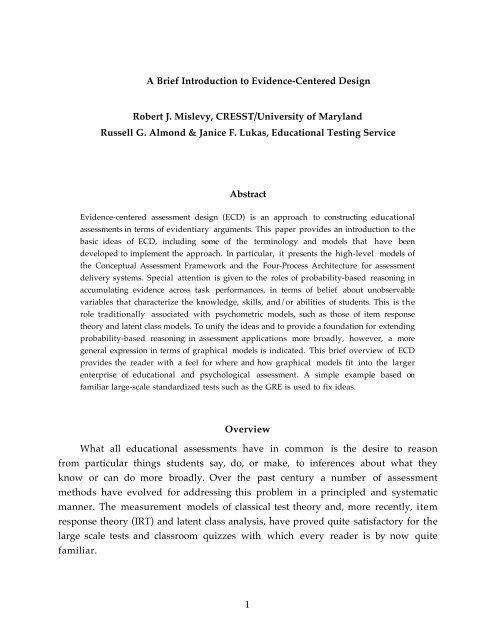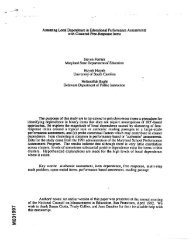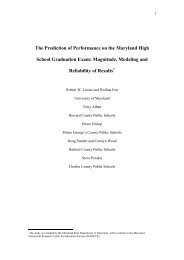A Brief Introduction to Evidence-Centered Design CSE Report 632 ...
A Brief Introduction to Evidence-Centered Design CSE Report 632 ...
A Brief Introduction to Evidence-Centered Design CSE Report 632 ...
You also want an ePaper? Increase the reach of your titles
YUMPU automatically turns print PDFs into web optimized ePapers that Google loves.
A <strong>Brief</strong> <strong>Introduction</strong> <strong>to</strong> <strong>Evidence</strong>-<strong>Centered</strong> <strong>Design</strong>Robert J. Mislevy, CRESST/University of MarylandRussell G. Almond & Janice F. Lukas, Educational Testing ServiceAbstract<strong>Evidence</strong>-centered assessment design (ECD) is an approach <strong>to</strong> constructing educationalassessments in terms of evidentiary arguments. This paper provides an introduction <strong>to</strong> thebasic ideas of ECD, including some of the terminology and models that have beendeveloped <strong>to</strong> implement the approach. In particular, it presents the high-level models ofthe Conceptual Assessment Framework and the Four-Process Architecture for assessmentdelivery systems. Special attention is given <strong>to</strong> the roles of probability-based reasoning inaccumulating evidence across task performances, in terms of belief about unobservablevariables that characterize the knowledge, skills, and/or abilities of students. This is therole traditionally associated with psychometric models, such as those of item responsetheory and latent class models. To unify the ideas and <strong>to</strong> provide a foundation for extendingprobability-based reasoning in assessment applications more broadly, however, a moregeneral expression in terms of graphical models is indicated. This brief overview of ECDprovides the reader with a feel for where and how graphical models fit in<strong>to</strong> the largerenterprise of educational and psychological assessment. A simple example based onfamiliar large-scale standardized tests such as the GRE is used <strong>to</strong> fix ideas.OverviewWhat all educational assessments have in common is the desire <strong>to</strong> reasonfrom particular things students say, do, or make, <strong>to</strong> inferences about what theyknow or can do more broadly. Over the past century a number of assessmentmethods have evolved for addressing this problem in a principled and systematicmanner. The measurement models of classical test theory and, more recently, itemresponse theory (IRT) and latent class analysis, have proved quite satisfac<strong>to</strong>ry for thelarge scale tests and classroom quizzes with which every reader is by now quitefamiliar.1






